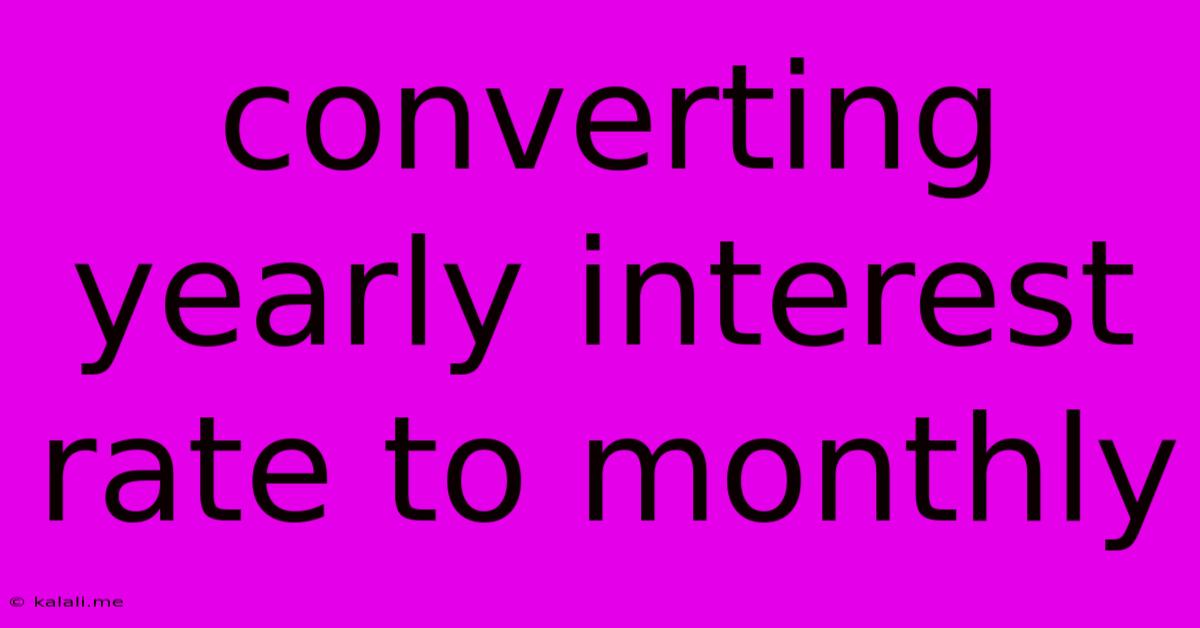Converting Yearly Interest Rate To Monthly
Kalali
May 21, 2025 · 3 min read

Table of Contents
Converting Yearly Interest Rate to Monthly: A Simple Guide
Meta Description: Learn how to easily convert your yearly interest rate to a monthly rate. This simple guide explains the formula and provides examples to help you understand the calculation. Essential for budgeting, loan repayments, and investment planning.
Understanding the monthly equivalent of your yearly interest rate is crucial for various financial calculations, from budgeting and loan repayments to investment planning. While it might seem complex, the conversion is surprisingly straightforward. This guide will walk you through the process, providing clear explanations and examples to ensure you master this essential financial skill.
Understanding the Concept
The yearly interest rate represents the total interest accrued over a year. To determine the monthly interest, we need to divide the annual rate by the number of months in a year (12). However, it's not as simple as a direct division, especially when dealing with compound interest, where interest earned also earns interest.
The Formula
The formula for converting a yearly interest rate to a monthly interest rate, considering compound interest, is:
Monthly Interest Rate = (1 + Yearly Interest Rate)^(1/12) - 1
Where:
- Yearly Interest Rate: This is your annual interest rate expressed as a decimal (e.g., 6% becomes 0.06).
- Monthly Interest Rate: This is the resulting monthly interest rate, also expressed as a decimal.
Example Calculations
Let's illustrate this with a few examples:
Example 1: Simple Conversion
Let's say you have a yearly interest rate of 6%. To convert this to a monthly rate:
- Express the yearly rate as a decimal: 6% = 0.06
- Apply the formula: (1 + 0.06)^(1/12) - 1 ≈ 0.00486755
- Convert back to percentage: 0.00486755 * 100% ≈ 0.49%
Therefore, a 6% yearly interest rate is approximately equivalent to a 0.49% monthly interest rate.
Example 2: Higher Interest Rate
Let's consider a yearly interest rate of 12%:
- Express the yearly rate as a decimal: 12% = 0.12
- Apply the formula: (1 + 0.12)^(1/12) - 1 ≈ 0.00948879
- Convert back to percentage: 0.00948879 * 100% ≈ 0.95%
Thus, a 12% yearly interest rate is approximately equivalent to a 0.95% monthly interest rate.
Important Considerations
- Compounding Frequency: The formula above assumes monthly compounding. If your interest compounds differently (e.g., quarterly, semi-annually), you'll need to adjust the denominator in the exponent accordingly (e.g., 4 for quarterly compounding, 2 for semi-annual).
- Approximations: The results are approximate due to rounding. Financial calculators or software may provide more precise figures.
- Effective Annual Rate (EAR): The effective annual rate takes into account the compounding effect throughout the year and provides a more accurate representation of the true annual cost of borrowing or return on investment.
Using a Calculator or Spreadsheet
For more accurate calculations, especially with complex scenarios, consider using a financial calculator or spreadsheet software like Microsoft Excel or Google Sheets. These tools often have built-in functions to simplify this conversion.
By understanding and applying this formula, you can easily convert yearly interest rates to their monthly equivalents, allowing for more accurate financial planning and analysis. Remember to always double-check your calculations, and don't hesitate to use calculators or spreadsheets for complex scenarios.
Latest Posts
Latest Posts
-
Find A File In Linux Recursively
May 21, 2025
-
I Made A Fireable Mistake At Work
May 21, 2025
-
How To Turn Off Hot Water
May 21, 2025
-
Can You Have Sex On Ramadan
May 21, 2025
-
The Hobbit Or Lord Of The Rings First
May 21, 2025
Related Post
Thank you for visiting our website which covers about Converting Yearly Interest Rate To Monthly . We hope the information provided has been useful to you. Feel free to contact us if you have any questions or need further assistance. See you next time and don't miss to bookmark.